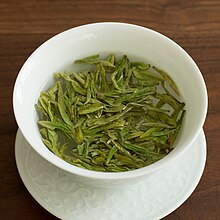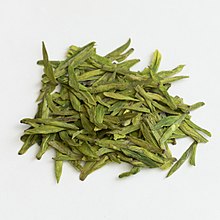
Oolong (, ; Chinese: 烏龍茶 is a traditional semi-oxidized Chinese tea produced through a process that includes withering the leaves under strong sun and allowing some oxidation to occur before curling and twisting. Most oolong teas, especially those of fine quality, involve unique tea plant cultivars that are exclusively used for particular varieties. The degree of oxidation, which is controlled by the length of time between picking and final drying, can range from 8% to 85% depending on the variety and production style. Oolong is especially popular in southeastern China and among ethnic Chinese in Southeast Asia, as is the Fujian preparation process known as the gongfu tea ceremony.

Green tea is a type of tea that is made from Camellia sinensis leaves and buds that have not undergone the same withering and oxidation process which is used to make oolong teas and black teas. Green tea originated in China, and since then its production and manufacture has spread to other countries in East Asia.

Chinese tea culture includes all facets of tea, both physical and spiritual, that have significantly influenced Chinese culture throughout history. Physically, it consists of the history of tea cultivation, brewing, serving techniques, methods of consumption, arts, and the tea ceremony. Tea culture is to take tea as a carrier, and through this carrier to spread various arts. Tea culture is an integral part of traditional Chinese culture. Tea culture is the organic fusion of tea and culture, which contains and embodies the manifestation of a certain period of material and spiritual civilization. Tea culture is the combination of tea art and spirit, and the expression of tea art through Spirituality. It emerged in China in the Tang dynasty, flourished in the Song and Ming dynasties, and declined in the Qing dynasty.

Lapsang souchong or Zhengshan xiaozhong is a black tea consisting of Camellia sinensis leaves that may be smoke-dried over a pinewood fire. This smoking is accomplished either as a cold smoke of the raw leaves as they are processed or as a hot smoke of previously processed leaves. The intensity of the smoke aroma can be varied by locating the leaves closer or farther from the source of heat and smoke or by adjusting the duration of the process. The flavour and aroma of smoked lapsang souchong is described as containing empyreumatic notes, including wood smoke, pine resin, smoked paprika, and dried longan; it may be mixed with milk but is not bitter and usually not sweetened with sugar. The tea originates from the Wuyi Mountains region of Fujian and is considered a Wuyi tea. It is also produced in Taiwan. It has been labelled as smoked tea, smoky souchong, tarry lapsang souchong and lapsang souchong crocodile. While the tea leaf grading system adopted the term souchong to refer to a particular leaf position, lapsang souchong may be made with any leaf of the Camellia sinensis plant, though it is not unusual for the lower leaves, which are larger and less flavourful, to be used as the smoking compensates for the lower flavour profile and the higher leaves are more valuable for use in unflavoured or unblended teas. In addition to its consumption as a tea, lapsang souchong is also used in stock for soups, stews and sauces or otherwise as a spice or seasoning. Beginning in the early 21st century, an unsmoked variety of lapsang souchong was developed in the village of Tong Mu Guan in the Wuyi mountains. The unsmoked variety has become increasingly popular, particularly in the Chinese domestic market.

Pu'er or pu-erh is a variety of fermented tea traditionally produced in Yunnan Province, China. In the context of traditional Chinese tea production terminology, fermentation refers to microbial fermentation, and is typically applied after the tea leaves have been sufficiently dried and rolled. As the tea undergoes controlled microbial fermentation, it also continues to oxidize, which is also controlled, until the desired flavors are reached. This process produces tea known as hēichá (黑茶), literally "black tea", though the term is commonly translated to English as "dark tea" to distinguish it from the English-language black tea.
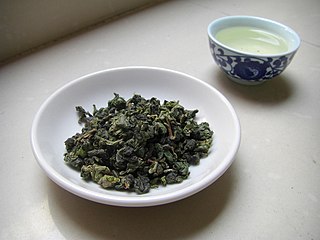
Tieguanyin is a variety of Chinese oolong tea that originated in the 19th century in Anxi in Fujian province. Tieguanyin produced in different areas of Anxi have different gastronomic characteristics.

The Korean tea ceremony is a traditional form of tea ceremony practiced in Korea. Darye literally refers to "etiquette for tea" or "tea rite" and has been kept among Korean people for over a thousand years. The chief element of the Korean tea ceremony is the ease and naturalness of enjoying tea within an easy formal setting.

Longjing tea, sometimes called by its literal translated name Dragon Well tea, is a variety of pan-roasted green tea from the area of Longjing Village in Hangzhou, Zhejiang Province, China. It is produced mostly by hand and renowned for its high quality, earning it the China Famous Tea title.
The history of tea in China is long and complex, for the Chinese have enjoyed tea for millennia. Scholars hailed the brew as a cure for a variety of ailments; the nobility considered the consumption of good tea as a mark of their status, and the common people simply enjoyed its flavour. In 2016, the discovery of the earliest known physical evidence of tea from the mausoleum of Emperor Jing of Han in Xi'an was announced, indicating that tea from the genus Camellia was drunk by Han dynasty emperors as early as the 2nd century BCE. Tea then became a popular drink in the Tang (618–907) and Song (960–1279) dynasties.

The history of tea spreads across multiple cultures over the span of thousands of years. With the tea plant Camellia sinensis native to East Asia and probably originating in the borderlands of southwestern China and northern Myanmar. One of the earliest accounts of tea drinking is dated back to China's Shang dynasty, in which tea was consumed as a medicinal drink. An early credible record of tea drinking dates to the 3rd century AD, in a medical text written by Chinese physician Hua Tuo. It first became known to the western world through Portuguese priests and merchants in China during the early 16th century. Drinking tea became popular in Britain during the 17th century. The British introduced commercial tea production to British India, in order to compete with the Chinese monopoly on tea by stealing green tea leaves from China, transporting them by train/road, resulting in them being fermented and thought fermented tea is the tea drunk in China. Hence the tea drank in the West is mostly fermented and not green fresh tea.

Yellow tea can refer to Chinese huángchá and Korean hwangcha.
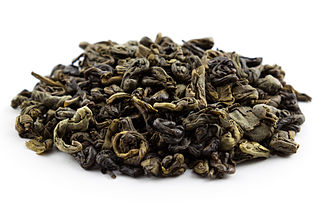
Gunpowder tea is a form of tea in which each leaf has been individually rolled into a small pellet. Its English name comes either from some resemblance of the pellets to gunpowder, or from a phrase in Chinese that phonetically resembles the word "gunpowder". This rolling method of shaping tea is most often applied either to green tea or to oolong tea.

Compressed tea, called tea bricks, tea cakes or tea lumps, and tea nuggets according to the shape and size, are blocks of whole or finely ground black tea, green tea, or post-fermented tea leaves that have been packed in molds and pressed into block form. This was the most commonly produced and used form of tea in ancient China prior to the Ming Dynasty. Although tea bricks are less commonly produced in modern times, many post-fermented teas, such as pu-erh, are still commonly found in bricks, discs, and other pressed forms. Tea bricks can be made into beverages like tea or eaten as food, and were also used in the past as a form of currency.

Dongfang meiren or baihao (白毫), among other Chinese names, is a heavily oxidized, non-roasted, tip-type oolong tea originating in Hsinchu County, Taiwan. It is an insect tea produced from leaves bitten by the tea jassid, an insect that feeds on the tea plant. Terpenes are released in the bitten leaves, which creates a honey-like taste. Oriental beauty, white-tip oolong, and champagne oolong are other names under which dongfang meiren is marketed in the West.
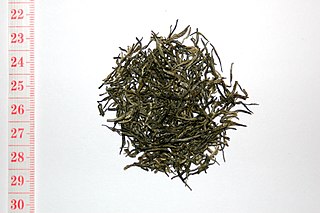
Xinyang Maojian tea, also known as Yu Maofeng, is a green tea produced in Xinyang, Henan.The fresh tea leaves of Xinyang Maojian Tea are harvested from tea trees and processed through various processes such as withering, kneading, and drying. It is often designated as a famous Chinese tea. It is one of the top ten famous teas in China and one of the famous specialties in Henan Province. The main producing areas are in Xinhe City, Pingqiao District, Guangshan County, Xin County, and Luoshan County. Created by Han tea farmers. In the early years of the Republic of China, the top five tea houses in Xinyang Tea District produced the high-quality Benshan Maojian tea, which was officially named "Xinyang Maojian".

Fermented tea is a class of tea that has undergone microbial fermentation, from several months to many years. The exposure of the tea leaves to humidity and oxygen during the process also causes endo-oxidation and exo-oxidation. The tea leaves and the liquor made from them become darker with oxidation. Thus, the various kinds of fermented teas produced across China are also referred to as dark tea, not be confused with black tea. The most famous fermented tea is pu'er produced in Yunnan province.

Tea processing is the method in which the leaves from the tea plant Camellia sinensis are transformed into the dried leaves for brewing tea.

High-mountain tea or gaoshan tea refers to several varieties of Oolong tea grown in the mountains of central Taiwan. It is grown at altitudes higher than 1,000 metres (3,300 ft) above sea level, and includes varieties such as Alishan, Dayuling, Yu Shan, Wushe, and Lishan. The high humidity and natural precipitation in the high mountain ranges of Nantou and Chiayi Counties make the region a suitable environment for growing tea plants. High Mountain Oolong is a tea that holds all of its original nutrients that are within the unfermented green tea. It does not hold the usual grass-like taste, hints of chestnut flavor paired with nutty aromas are often described. The fermentation process that removes the harsh ingredients allows the tea to taste flavorful.

Matcha (抹茶) ; is a finely ground powder of specially grown and processed green tea leaves that originated in China. Later, the green color exhibited in most modern matcha was developed in Japan, where most matcha is produced today. In the 12th century at the latest, Chinese compressed tea, the raw material for matcha, was introduced to Japan. When the production of compressed tea was banned in China in 1391, matcha was abandoned in China and developed in Japan thereafter.
